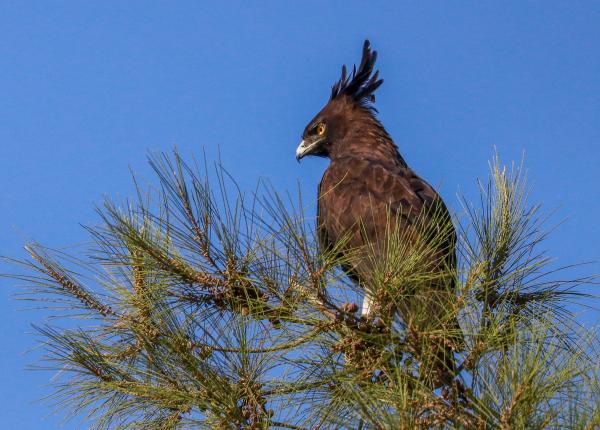Did You Know?
- On average, female Long-crested Eagles weigh 27% more than the males.
- This bird is also know as the Long-crested Hawk Eagle
- This raptor may be in direct competition with the another raptor, the Black Sparrowhawk, for nesting sites.
How The Peregrine Fund is Helping
In Kenya, our scientists are working hard to learn about and protect all raptors and their habitats. Through environmental education efforts, they also are working to put a stop to the common practice of poisoning carcasses to kill large predators, which also kills a host of wildlife including vultures, eagles, and other scavenging birds. These efforts will certainly benefit all raptors of the region, including the Long-crested Eagle. Additionally, our efforts in scientific research, habitat conservation, education, and community development help conserve raptors on a global scale. We also supply literature to researchers from our avian research library, which helps scientists around the world gather and share important information on raptor conservation.
Where They Live
The Long-crested Eagle has a wide distribution across much of the African continent. It has adapted well to living in all sorts of habitats from forested areas and wooded savannas, to moist woodland areas which are often next to marshes, wetlands, and rivers.
It can even be found in exotic tree plantations, agricultural plantings, and other modified habitats, which may be its way of adapting to the loss of some of its native forest habitat.
What They Do
Long-crested Eagle is an appropriate name for this stunning bird of prey. Perhaps the first thing one notices when they see this bird is that it indeed does have a very long crest. When it is lifted, the bird appears to be wearing a very fancy, slightly floppy, pointed black hat. This crest makes this bird very distinctive. As does the rest of its coloration. It is a relatively small eagle with all-dark feathers all over its body, except for its tail and when it is flying. Its tail, like many raptor tails, is black with white bands. In flight, this eagle shows its white carpal patches.
This eagle is mostly active in the afternoons until just after sundown and it spends a lot of time perched on exposed branches in tall trees or power poles. It doesn't spend too much time soaring.
Why They Need Our Help
Thankfully, the Long-crested Eagle is classified as Least Concern by the IUCN, and in some areas its population might even be increasing. This is good news for this bird of prey. However, that doesn't mean that it still doesn't face many threats that could negatively affect its population in the future. The biggest threats it faces are habitat fragmentation, habitat loss (including the draining of wetlands), poisoning, and collisions with power lines and vehicles.
This species has done well in some areas where exotic tree plantations have been created.
What They Eat
Rats, rats, and more rats! The Long-crested Eagle is a rodent specialist. It feeds mainly on large, diurnal rodents and mice, including vlei rat, water rat, mole rat, mice, as well as shrews. Though these mammals make up the majority of the Long-crested Eagle's diet, that doesn't mean it won't take other prey if the opportunity arises. In fact, this eagle has been documented feeding on birds as well, including passerines and Red-necked Francolin. It might come as a surprise that this eagle has also taken other raptor species, such as the African Wood-Owl. It will also take reptiles, arthropods, and sometimes even fish or fruit.
This species is a still hunter. This means it sits on an exposed perch, waiting for prey to appear. When this eagle sees something it wants to turn into its dinner, it will simply drop from its perch onto the prey, which it kills with its strong feet and sharp talons.
Nests, Eggs, and Young
Long-crested Eagles build relatively small, often well-concealed stick nests The nests usually measure between 50–80 cm across and 15–30 cm deep. The nest is built in relatively tall trees, usually at its main fork. These trees are often located along the edge of forest or woodland.
When it is time, the female will lay between 1-2 eggs which must be incubated for over one month - around 42 days. Once the nestlings hatch, they are covered in fluffy down which changes from all gray to gray above and white below. Over the next nearly two months, the nestlings will grow quickly. When the chick is very young, the mother will tear off small pieces of meat for eaglets and delicately feed them with her bill. Later, as the nestlings grow, they will be able to tear off and eat the meat on their own. They will be ready to fly for the first time when they are between 53–58 days old.
Long-crested Eagle and the World Center for Birds of Prey
The World Center for Birds of Prey offers many fun ways to learn about birds of prey. The visitor center offers interactive displays, tours, interesting videos and a children's room with activities from coloring sheets to quizzes to costumes and a touch table for the curious mind. We have several different raptor species as part of our Avian Ambassador team. Meet Grayson the Harpy Eagle, or Sky, the Bald Eagle. Knowledgeable staff and volunteers are on hand to answer any questions you may have about Long-crested Eagles or any other bird of prey.
References:
BirdLife International. 2016. Lophaetus occipitalis. The IUCN Red List of Threatened Species 2016: e.T22696134A93546422. https://dx.doi.org/10.2305/IUCN.UK.2016-3.RLTS.T22696134A93546422.en. Downloaded on 09 August 2021.
Global Raptor Information Network. 2021. Species account: Long-crested Eagle Lophaetus occipitalis. Downloaded from http://www.globalraptors.org on 9 Aug. 2021
Kemp, A. C., P. F. D. Boesman, and J. S. Marks (2020). Long-crested Eagle (Lophaetus occipitalis), version 1.1. In Birds of the World (P. G. Rodewald and S. M. Billerman, Editors). Cornell Lab of Ornithology, Ithaca, NY, USA. https://doi.org/10.2173/bow.loceag1.01.1









